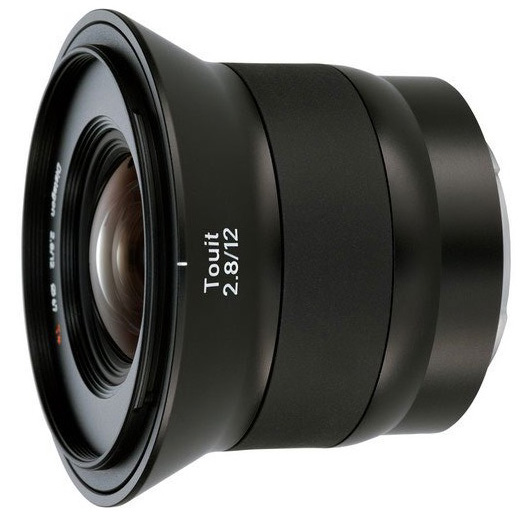



The Fujifilm X-E1 is one of the most popular mirrorless cameras on the market and has a range of quality lenses to match. When choosing lenses for the Fujifilm X-E1 (X-Mount lenses), remember that the camera has a 1.5x crop factor, meaning that the focal length equivalent on a 35mm camera is approximately 1.5 times longer (a 12mm X-mount lens is equivalent to a 18mm lens on a 35mm camera, etc.). You also should make sure that your X-E1 has the latest firmware updates for the fastest autofocus speed.
 Fujifilm 18-55mm f/2.8-4.0 ($999 for the kit)
Fujifilm 18-55mm f/2.8-4.0 ($999 for the kit)Weight: 11.7 oz.
Max Aperture: f/2.8
Pros: Versatility and good low light performance for a kit lens
Cons: None
The Fujifilm 18-55mm is not your typical kit lens. Most kit lenses are made with plastic components and have marginal optics, but the Fujifilm 18-55mm has a sturdy metal build, excellent sharpness, fast autofocus, and good low light performance for a zoom lens. Compared to kit lenses offered by mirrorless competitors Olympus and Sony, the Fujifilm 18-55mm is best in class. The lens also is offered at a significant discount with the Fujifilm X-E1 camera body at $999 for the pair (on its own, the lens retails for $699).
 Zeiss 12mm f/2.8 Touit ($1,250)
Zeiss 12mm f/2.8 Touit ($1,250)Weight: 9.5 oz.
Max Aperture: f/2.8
Pros: Exceptional image quality
Cons: Cost
In an exciting development for those who shoot with Fujifilm, lensmaker Carl Zeiss released two new high-end X-Mount lenses (Zeiss also makes the same lenses with E-Mount for Sony mirrorless cameras). The Zeiss 12mm Touit is an extremely impressive wide-angle lens with a focal length equivalent of 18mm on a 35mm camera. For those who shoot ultra-wide angle photography, it's the single best lens on the market for the Fujifilm X-E1. The Fujifilm 14mm below also is an excellent lens and is cheaper.
 Fujifilm 14mm f/2.8 ($899)
Fujifilm 14mm f/2.8 ($899)Weight: 8.3 oz.
Max Aperture: f/2.8
Pros: Exceptional image quality
Cons: Cheaper than the Zeiss 12mm Touit, but still costly
For wide-angle lenses to pair with the Fujifilm X-E1, it’s a tough choice between the Zeiss 12mm above and the Fujifilm 14mm—both are exceptional. With a focal length equivalent of 21mm on a 35mm camera, the Fujifilm 14mm f/2.8 is wide enough for grand landscape shots but not too wide (21mm is the preferred wide-angle focal length of this author). The lens also features a sturdy all-metal build and produces sharp, high-quality images with minimal distortion. Based on the price and weight differences between the two lenses, we give the nod to the Fujifilm 14mm.
 Fujifilm 23mm f/1.4 ($899)
Fujifilm 23mm f/1.4 ($899)Weight: 10.6 oz.
Max Aperture: f/1.4
Pros: Low light performance
Cons: Cost
Set to be released on October 16, 2013, the new Fujifilm 23mm f/1.4 is an ultra-high-end prime lens that should be among the top performers of any brand. With an equivalent focal length of 35mm on a 35mm camera, it’s an ideal lens for travel, street photography, and everyday use. A maximum of aperture of f/1.4 will produce outstanding images in low light and the lens is optically corrected for minimal distortion. Although the 23mm f/1.4 does have a high price tag, it’s just the lens that professionals and enthusiasts have been waiting for.
 Zeiss 32mm f/1.8 Touit ($900)
Zeiss 32mm f/1.8 Touit ($900)Weight: 7.4 oz.
Max Aperture: f/1.8
Pros: Low light performance and sharpness
Cons: Cost
The 32mm Touit is the second in Zeiss’s line of X-mount prime lenses for Fujiflim. There’s no doubting the quality of the 32mm Touit, which produces extremely sharp images and has a maximum aperture of f/1.8. But at $900, the 32mm Touit makes more sense for Sony NEX mirrorless cameras—the lens alternatives for that camera system aren’t as impressive. Nothing against the Zeiss 32mm Touit, but we recommend the Fujifilm 35mm below, which is cheaper and performs even better in low light.
 Fujifilm 35mm f/1.4 ($599)
Fujifilm 35mm f/1.4 ($599)Weight: 6.6 oz.
Max Aperture: f/1.4
Pros: Sharpness and low light performance
Cons: Lens cap looseness
All things considered, the 35mm f/1.4 may be the best Fujifilm X-Mount lens on the market and is a great value. With a focal length equivalent of 53mm on a 35mm camera, the lens performs exceptionally well in low light, is extraordinarily sharp, produces excellent bokeh, and weighs just 6.6 ounces. The only real shortcoming is that the lens cap has a tendency to fall off (you should also make sure that the camera has the latest firmware updates for the fastest autofocus).
 Fujifilm 55-200mm f/3.5-4.8 ($699)
Fujifilm 55-200mm f/3.5-4.8 ($699)Weight: 20.5 oz.
Max Aperture: f/3.5
Pros: Good optics and low light performance for a telephoto zoom
Cons: Weight, cost
The Fujifilm 55-200mm is a sharp telephoto zoom lens that captures impressive images throughout its range, performs well in low light for a telephoto zoom, and comes with optical image stabilization. One shortcoming of this lens is its weight of 20.5 ounces, which is closer to the weight a telephoto zoom for a DSLR than a mirrorless camera. It’s also expensive, but if image quality is your highest priority, the Fujifilm 55-200mm is the best performing telephoto zoom for the Fujifilm X-E1.
 Fujifilm 50-230mm f/4.5-6.7 ($399)
Fujifilm 50-230mm f/4.5-6.7 ($399)Weight: 13.2 oz.
Max Aperture: f/4.5
Pros: Long zoom range
Cons: Low light performance
Set to be released on November 15, 2013, the new Fujifilm 50-230mm has an extremely long focal length equivalent of 76-350mm on a 35mm camera. It also comes with optical image stabilization and is relatively inexpensive at around $400. The biggest weakness of this lens is its aperture range of f/4.5-6.7, which is slower than most telephoto zoom lenses for mirrorless cameras. But if most of your shooting will occur during the brighter hours, the image quality of the Fujifilm 50-230mm will not disappoint.